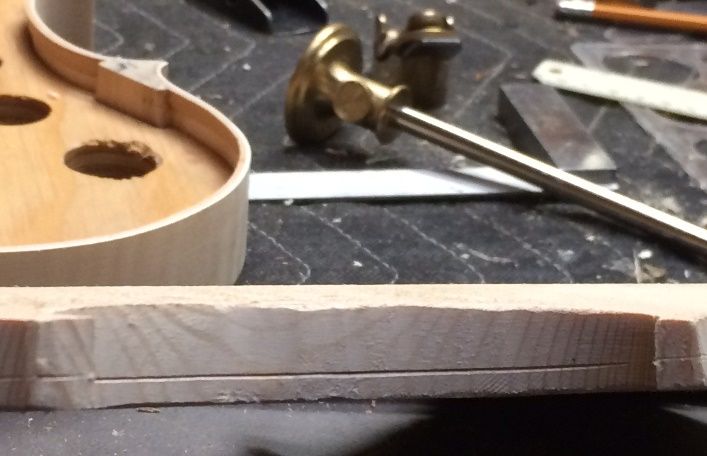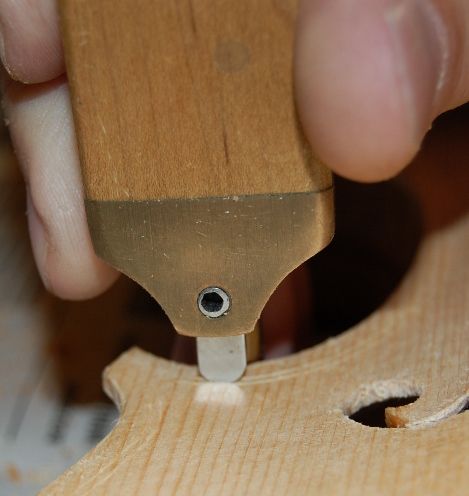Carving the Archings
Why are Archings so Important?
I wish I could give a scientific, rock-solid answer, based on the physics of sound, plate vibrations, etc., but I can’t: All I can say for certain is that the arching of the plates is possibly the single most important factor in producing good sound in a violin…with choice of wood being the closest other contender…maybe.
I was told that, during his career, Bob Bein of “Bein & Fushi” violins, could tke a single glance over the individual archings of a pile of violins, and immediately sort them into the “keep” pile and the “discard” pile…and he was consistently correct. The ones he kept became great-playing instruments and the others…well, who knows? They went elsewhere, and someone else struggled with them. But all he was seeing were the archings. These instruments were not even set up– and he was not thumping and listening (as I still do)…his eye told him what the possibilities were. I wish I could explain that, but I can’t.
In the last few years, mainly due to the research of other makers, I have become convinced that a particular curvature, predictable by mathematics, and, importantly, by mathematics that were completely available to the Cremonese makers, may be largely responsible for that sought-after sound. These curves are called either “hypo-cycloid” curves, or “curtate cycloid” curves.
Is it possible, still, that some “holy grail” of tonewood was the key? Sure…but other makers of the same period, using what seems to be the same wood, were not able to capture that tone. Furthermore, some modern makers have managed to acquire wood from that time period and area, and have made violins of it. Nothing remarkable resulted.
Could it still be the subsequent treatment of the wood…some arcane chemical treatment, that gives that special sound? I suppose it could be, but every time someone does chemical analyses of the tiny, precious chips of wood from those instruments, after repairs, all they seem to come up with is that it may have a mineral ground of some sort (jury is still out on that one), and that, otherwise, it simply has a varnish comprised of linseed oil and larch resin, or pine resin, or something similar. Nothing special there, either. Annnd, all the modern-day experiments done with rabbit urine, horse manure, potassium silicate, and a variety of unlikely-sounding candidates for “the secret” have all turned out pretty unimpressive, to the best of my knowledge. So…no secrets to reveal, today. Sorry.
Personally, I had finally come to the conclusion that the Cremonese makers simply were the best makers the world had ever seen. But the hypo-cycloid archings (also called “curtate cycloids”) may actually hold a key. I do know that, since I began attempting to use the curtate cycloid arching curves, players have picked out those particular instruments, and said “Whatever you did on this instrument, keep doing it! This one is the best!” (Or similar accolades….) And (so importantly) it turns out that virtually all of the Cremonese master instruments match these curves with amazing accuracy. (Just as if they planned it that way!)
So…No more “by guess and by golly!” I have done it with compass and straightedge and calculator, for my own models, but this time I lifted the arching template designs from the poster. Incidentally, when I take my arching templates directly off the posters, I get the same curves, so…I made the arching templates, both front and back, longitudinal and transverse, and I do try to use them.
Edge Thickness:
The beginning step is to establish the edge thickness. This particular Guarneri model seems to have begun with 4 millimeter edge thickness, which in some areas ended up more like 3.7 or 3.8. So, I set my wheel marking gauge to 4mm and scribed a line all the way around both plates:


Arching, and Arching Templates
Then I carve away the excess wood, down to the line, making a flat area at least 10-12 mm wide, all the way around the perimeter of the plate, and begin carving away the excess thickness, curving up from that “platform,” up to the center high spot of the plate. At this point I know the arching is still far too high and puffy, but I will begin using arching templates, along with gouges and finger-planes, to bring it into some semblance of an ideal arch. The final shaping will be done using sharp scrapers and low-angle light, to reveal irregularities of any sort. Here is the (very rough) preliminary arching for the front plate:

I use arching templates, either derived mathematically, or traced from a poster, to adjust the shape of the plates.




The back plate arching, though different from the front, is accomplished in exactly the same manner. I will show pictures of it another day. I’m getting pretty tired. Once the outer archings are as close as I can get them, I will flip the plates over in the cradle, and carve the inside arching, carefully monitoring the thicknesses all over the plate. This pattern of thicknesses is called “Plate Graduation”, and they seem to be fairly important, too, though not nearly so much as the archings.
More later.
Thanks for looking.

 Follow
Follow













